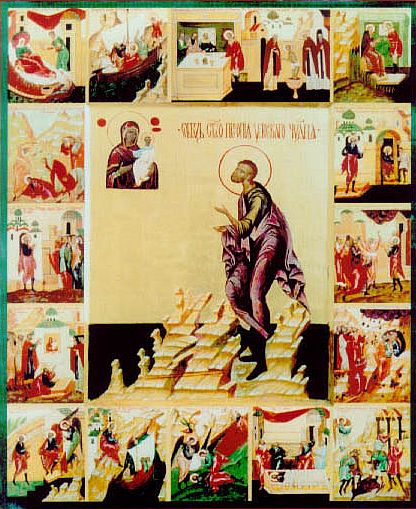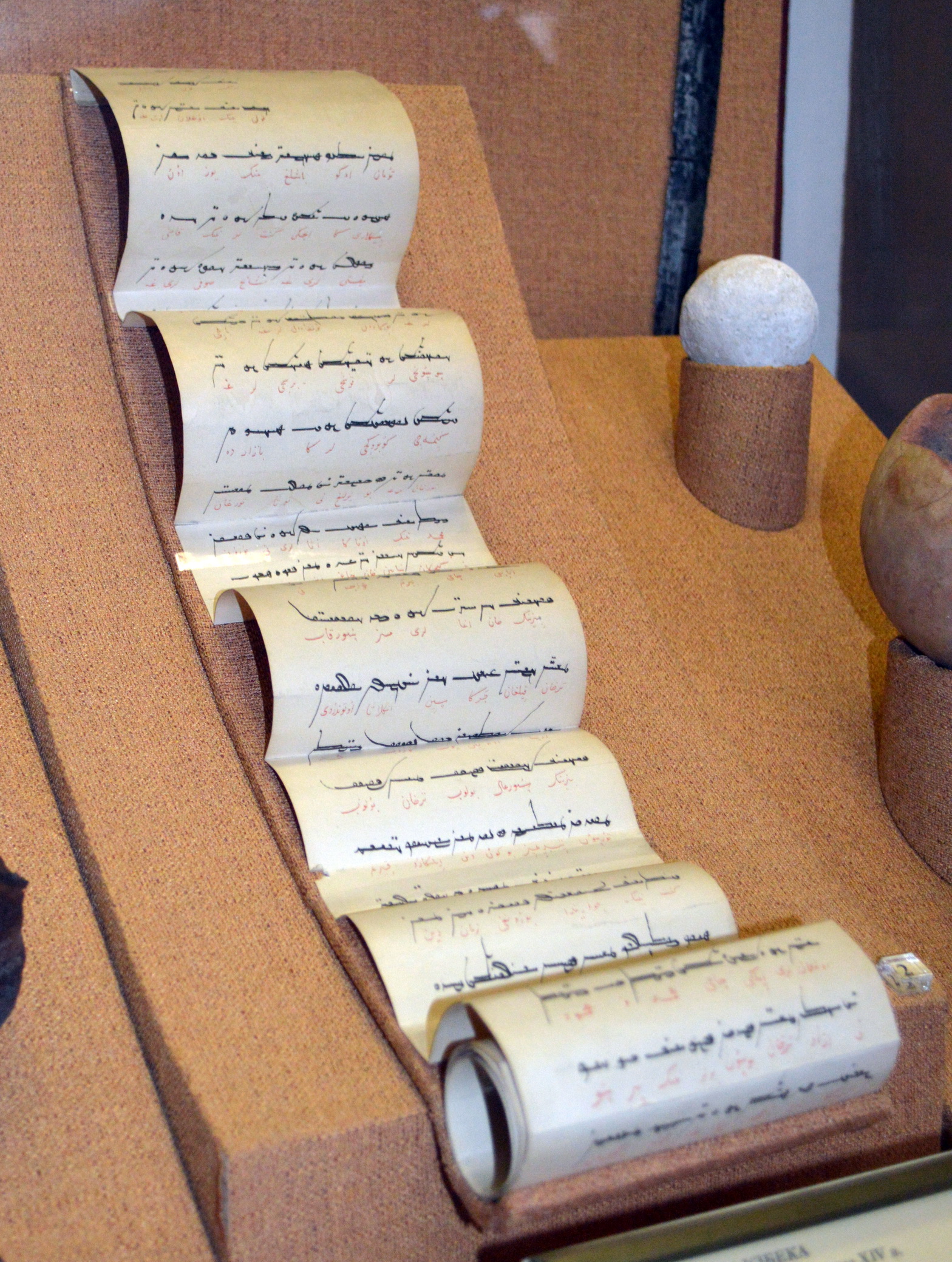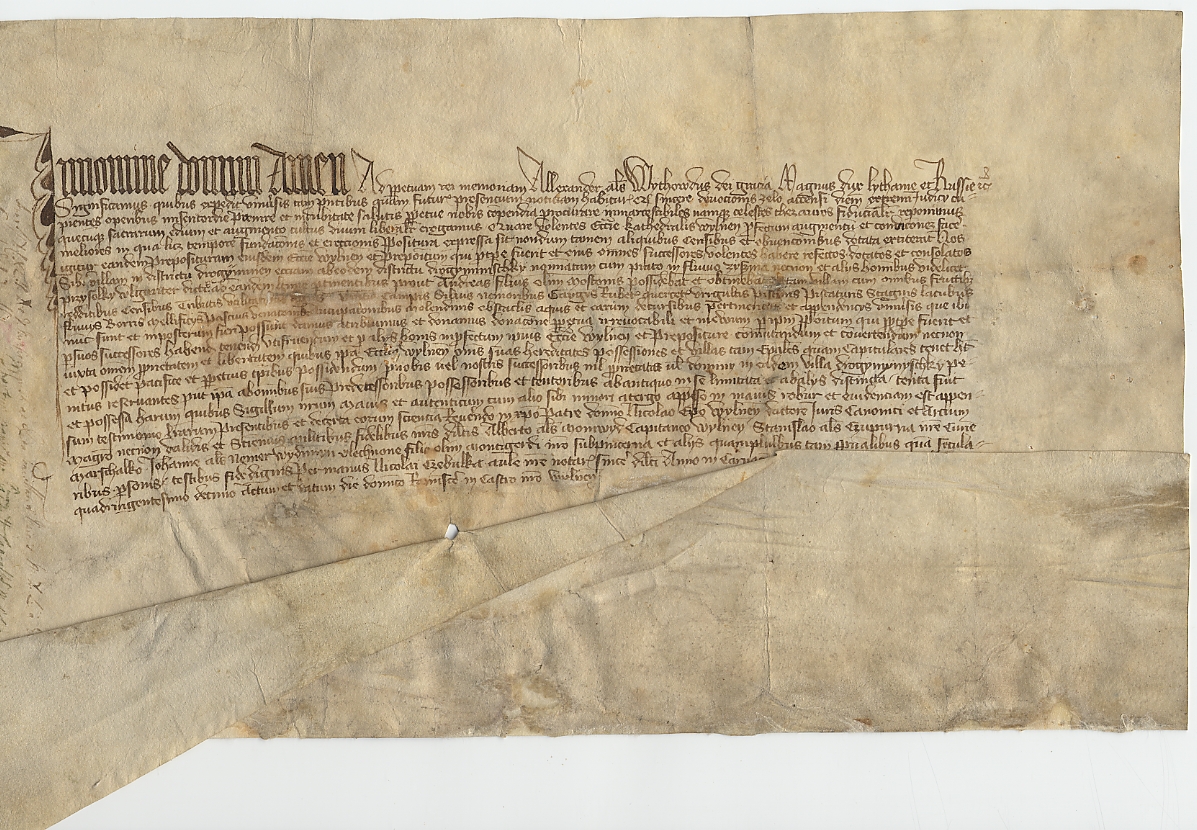|
Vasili I Of Moscow
Vasily I Dmitriyevich (; 30 December 137127 February 1425) was Grand Prince of Vladimir and Moscow from 1389. He was the heir of Dmitry Donskoy, who reigned from 1359 to 1389. He entered an alliance with the Grand Duchy of Lithuania in 1392 and married Sophia, the only daughter of Vytautas, though the alliance turned out to be fragile, and they waged war against each other in 1406–1408. The raid on the Volga region in 1395 by the Turco-Mongol emir Timur resulted in a state of anarchy for the Golden Horde and the independence of Moscow. In 1412, Vasily resumed submission to the Horde. Family and early life Vasily was the oldest son of Dmitry Donskoy and Grand Princess Eudoxia, daughter of Grand Prince Dmitry Konstantinovich of Nizhny Novgorod. Reign While still a young man, Vasily, who was the eldest son of Grand Prince Dmitry Donskoy (ruled Moscow 1359–89), travelled to the Tatar khan Tokhtamysh (1383) to obtain the Khan's '' yarlik'' (patent) for his father for the ... [...More Info...] [...Related Items...] OR: [Wikipedia] [Google] [Baidu] |
Sophia Of Lithuania
Sophia Vitovtovna of Lithuania (, ; 1371 – 1453) was the grand princess of Moscow as the wife of Vasily I from 1391 to 1425. She was regent for her son Vasily II from 1425 to 1432. Her father was Vytautas, the grand duke of Lithuania. Life She was the daughter of Vytautas the Great of Lithuania and his first wife, Anna. On 21 January 1391, while her father was engaged in the Lithuanian Civil War, she married Vasili I of Moscow. She was the longest serving consort of Russia. After Vasili's death in 1425 she became regent for their ten-year-old son Vasili II. Her father supported Vasili's claim to the throne, which was disputed by his uncle, Yuri of Zvenigorod. Sophia was buried in the Ascension Convent; the sarcophagus was moved in 1929 to the Cathedral of the Archangel by Soviet authorities. Children She and Vasili I had at least nine children, five boys (of which only one survived to mature adulthood) and four girls: * Anna of Moscow (1393 – August 1417), wife of ... [...More Info...] [...Related Items...] OR: [Wikipedia] [Google] [Baidu] |
Timur
Timur, also known as Tamerlane (1320s17/18 February 1405), was a Turco-Mongol conqueror who founded the Timurid Empire in and around modern-day Afghanistan, Iran, and Central Asia, becoming the first ruler of the Timurid dynasty. An undefeated commander, he is widely regarded as one of the greatest military leaders and tacticians in history, as well as one of the most brutal and deadly. Timur is also considered a great patron of art and architecture, for he interacted with intellectuals such as Ibn Khaldun, Hafez, and Hafiz-i Abru and his reign introduced the Timurid Renaissance. Born into the Turkicized Mongol confederation of the Barlas in Transoxiana (in modern-day Uzbekistan) in the 1320s, Timur gained control of the western Chagatai Khanate by 1370. From that base he led military campaigns across Western, South, and Central Asia, the Caucasus, and Southern Russia, defeating in the process the Khans of the Golden Horde, the Mamluks of Egypt and Syria, the emerg ... [...More Info...] [...Related Items...] OR: [Wikipedia] [Google] [Baidu] |
Komi Peoples
The Komi ( also ) are a Permians, Permian ethnic group who are indigenous to, and primarily inhabit a region around the basins of the Vychegda, Pechora River, Pechora and Kama river, Kama rivers in northeastern European Russia. They mostly reside in the Komi Republic, Perm Krai, Murmansk Oblast, Khanty–Mansi Autonomous Okrug, and Nenets Autonomous Okrug in the Russia, Russian Federation. Name There have been at least three names for the Komi: ''Permyaks'' (), ''Zyrians'' (), and ''Komi'' (). The name ''Permyaks'' first appeared in Russian sources in the 10th century and came from the ancient name of the land between the Mezen River, Mezen and Pechora River, Pechora rivers – ''Perm'' or ''Great Perm'' (). Several origins of the name have been proposed, but the most accepted is from Veps language, Veps '''' "back, outer or far-away land". In Old Norse and Old English, it was known as ''Bjarmaland'' and '''' respectively, but those Germanic names designate a wider area than the R ... [...More Info...] [...Related Items...] OR: [Wikipedia] [Google] [Baidu] |
Veliki Ustyug
Veliky Ustyug () is a town in Vologda Oblast, Russia, located in the northeast of the oblast at the confluence of the Sukhona and Yug Rivers. As of the 2010 Census, its population was 31,665. Veliky Ustyug has a great historical significance and was one of the major cities of the Russian North. It preserved some of the past urban structure and many of the architectural monuments. It has lost its former leading role and is nowadays mostly known for tourism. Location and etymology Veliky Ustyug is close to the confluence of the Sukhona (flowing from the west) and the Yug (from the south) rivers. Downstream from this confluence the rivers form a single waterway known as the Northern Dvina, sometimes referred to as the Little Northern Dvina. The historical center of the town is on the left (high) bank of the Sukhona and, in contrast to many historical Russian towns, there is an embankment along the Sukhona. Dymkovskaya Sloboda and Troitse-Gledensky Monastery are on the ri ... [...More Info...] [...Related Items...] OR: [Wikipedia] [Google] [Baidu] |
Vologda
Vologda (, ) is a types of inhabited localities in Russia, city and the administrative center of Vologda Oblast, Russia, located on the river Vologda (river), Vologda within the watershed of the Northern Dvina. Population: The city serves as a major transport hub of the Northwestern Federal District, Northwest of Russia. The Ministry of Culture (Russia), Ministry of Culture of the Russian Federation has classified Vologda as a historic city, one of 41 in Russia and one of only three in Vologda Oblast. The Russian Cultinfo website wrote that there were 224 monuments of historical, artistic and cultural importance in Vologda. History Foundation The official founding year of Vologda is 1147, File:LiAZ-5256.46 in Vologda.jpg, Bus LiAZ-5256 File:Pavlovo Bus «Aurora» 70.jpg, PAZ-4230 "Aurora" File:Mercedes-Benz bus 5.jpg, Mercedes-Benz O345 File:Ikarus 280.33 in Vologda - 2009.jpg, Ikarus 280 File:Vologda MAZ-206.jpg, Minsk Automobile Plant, MAZ-206 File:VMZ «Olimp» bus 3.j ... [...More Info...] [...Related Items...] OR: [Wikipedia] [Google] [Baidu] |
Kaluga
Kaluga (, ) is a types of inhabited localities in Russia, city and the administrative center of Kaluga Oblast, Russia. It stands on the Oka River southwest of Moscow. Its population was 337,058 at the 2021 census. Kaluga's most famous resident, the space travel pioneer Konstantin Tsiolkovsky, worked there as a school teacher from 1892 to 1935. The Tsiolkovsky State Museum of the History of Cosmonautics in Kaluga is dedicated to his theoretical achievements and to their practical implementations for modern space research, hence the motto on the city's coat of arms: , ''Kolybélʹ kosmonávtiki'' ("''The Cradle of Space-Exploration''"). History Kaluga, founded in the mid-14th century as a border fortress on the southwestern borders of the Grand Duchy of Moscow, first appears in the historical record in chronicles in the 14th century as ''Koluga''; the name comes from Old Russian ''kaluga'' is "bog, quagmire". During the period of Tartar raids it was the western end of the Oka ... [...More Info...] [...Related Items...] OR: [Wikipedia] [Google] [Baidu] |
Murom
Murom (, ) is a historical types of inhabited localities in Russia, city in Vladimir Oblast, Russia, which sprawls along the west bank of the Oka River. It borders Nizhny Novgorod Oblast and is situated from the administrative center Vladimir, Russia, Vladimir. Its population as of the 2021 Russian census, 2021 Census was 107,497. History In the 9th century AD, the city marked the easternmost settlement of the East Slavs in the land of the Finnic Volga Finns, Muromians. The ''Primary Chronicle'' mentions it as early as AD 862. It is, thus, one of the oldest cities in Russia. Circa 900 AD, it was an important trading post from Volga Bulgaria to the Baltic Sea. Between AD 1010 and AD 1393, it was the capital of a separate principality, whose rulers included Saint Boris and Gleb, Gleb, assassinated in AD 1015 and canonized in AD 1071, Saint Prince Konstantin of Murom, Konstantin the Blessed, and Saints Peter and Fevronia of Murom, subjects of an opera by Nikolai Rimsky-Korsak ... [...More Info...] [...Related Items...] OR: [Wikipedia] [Google] [Baidu] |
Nizhny Novgorod-Suzdal
The Principality of Nizhny Novgorod-Suzdal (), also known as Suzdal-Nizhny Novgorod (also spelt ''Nizhnii''), was a principality formed in 1341. Its main towns were Nizhny Novgorod, Suzdal, Gorokhovets, Gorodets, and Kurmysh. Nizhny Novgorod was the seat of the principality from 1350. The prince Dmitry of Suzdal obtained the yarlik (patent) for the title of Grand Prince of Vladimir from khan Nawruz Beg in 1360. History merged the principalities of Suzdal and Nizhny Novgorod in 1341 with the approval of Jani Beg, who became Khan of the Golden Horde next year. In 1341, after the death of Ivan Kalita, Khan Uzbek divided the main territories of northeastern Rus'. Part of the land, which included Nizhny Novgorod, Gorodets and Unzha, became the property of Prince Konstantin of Suzdal. An independent Nizhny Novgorod-Suzdal Principality was formed, which occupied a vast territory. In the east, its border ran along the Sura River, in the southeast and south - along the rivers Pyana ... [...More Info...] [...Related Items...] OR: [Wikipedia] [Google] [Baidu] |
Tamerlane
Timur, also known as Tamerlane (1320s17/18 February 1405), was a Turco-Mongol tradition, Turco-Mongol conqueror who founded the Timurid Empire in and around modern-day Afghanistan, Iran, and Central Asia, becoming the first ruler of the Timurid dynasty. An undefeated commander, he is widely regarded as one of the greatest military leaders and tacticians in history, as well as one of the most brutal and deadly. Timur is also considered a great patron of art and architecture, for he interacted with intellectuals such as Ibn Khaldun, Hafez, and Hafiz-i Abru and his reign introduced the Timurid Renaissance. Born into the Turkification, Turkicized Mongol confederation of the Barlas in Transoxiana (in modern-day Uzbekistan) in the 1320s, Timur gained control of the western Chagatai Khanate by 1370. From that base he led military campaigns across Western Asia, Western, South Asia, South, and Central Asia, the Caucasus, and Southern Russia, defeating in the process the Khans of the Gol ... [...More Info...] [...Related Items...] OR: [Wikipedia] [Google] [Baidu] |
Tokhtamysh
Tokhtamysh ( Turki/ Kypchak and Persian: توقتمش; ; ; – 1406) was Khan of the Golden Horde from 1380 to 1395. He briefly succeeded in consolidating the Blue and White Hordes into a single polity. Tokhtamysh belonged to the House of Borjigin, tracing his ancestry to Genghis Khan. Spending most of his younger years fighting against his father's cousin Urus Khan and his sons, Tokhtamysh sought help from the Turco-Mongol warlord Timur, with whose help he succeeded in defeating his enemies. Tokhtamysh rose to power during a tumultuous period in the Golden Horde, which was severely weakened after a long period of division and internecine conflict. From a fugitive, Tokhtamysh had become a powerful monarch, quickly solidifying his authority in both wings of the Golden Horde. Encouraged by his success, as well as the growth of his manpower and wealth, Tokhtamysh went on a military expedition to the Russian principalities, sacking Moscow in 1382. He reasserted the Tatar–Mo ... [...More Info...] [...Related Items...] OR: [Wikipedia] [Google] [Baidu] |
Yarlik
A jarlig, also written ''yarlyk'' (from ), is an edict, permission, license, or written commandant of Mongol and Chinggisid rulers' "formal diplomas." It was one of three non-fundamental law pronouncements that had the effect of regulation or ordinance, the other two being ''debter'' (a record of precedence cases for administration and judicial decisions) and ''billing'' (maxims or sayings attributed to Genghis Khan). The jarlig provides important information about the running of the Mongol Empire. Ögedei Khagan prohibited the nobility from issuing gergees (tablet that gave the bearer authority to demand goods and services from civilian populations) and jarliqs in the 1230s. From the mid-13th to mid-15th centuries, all princes of Northeastern Rus received jarliq authorizing their rule. The issuing of jarlyk on governing of Rus finalized the establishment of the title of Grand Duke of Vladimir (Grand Prince). Initially, those jarliq came from the qaghan in Karakorum, but after ... [...More Info...] [...Related Items...] OR: [Wikipedia] [Google] [Baidu] |
Vitovt
Vytautas the Great (; 27 October 1430) was a ruler of the Grand Duchy of Lithuania. He was also the prince of Grodno (1370–1382), prince of Lutsk (1387–1389), and the postulated king of the Hussites. In modern Lithuania, Vytautas is revered as a Folk hero, national hero and was an important figure in the Lithuanian National Revival, national rebirth in the 19th century. ''Vytautas'' is a popular male given Lithuanian name, name in Lithuania. In commemoration of the 500-year anniversary of his death, Vytautas Magnus University was named after him. Monuments in his honour were built in many towns in independent Lithuania during the History of Lithuania#Independent interwar Lithuania (1918–1940), interwar period from 1918 to 1939. Vytautas knew and spoke the Lithuanian language with his cousin Władysław II Jagiełło, Jogaila. Struggle for power 1377–1384 Vytautas' uncle Algirdas had been Grand Duke of Lithuania until his death in 1377. Algirdas and Vytautas' father K� ... [...More Info...] [...Related Items...] OR: [Wikipedia] [Google] [Baidu] |







